|
Pivotal World Series Moments
Stengel's Mad Dash
1923 World Series Game 1: New York Giants @ New York Yankees
Despite winning two straight American League pennants, Yankees manager Miller Huggins had not fully won the allegiance of T. L. Huston, one of the club's co-owners with Jacob Ruppert. Huston demanded Huggins' firing following theYanks' second straight loss to the crosstown rival Giants in the 1922 World Series. In addition to not beating the hated John McGraw, Huggins was guilty of "not controlling" Babe Ruth.
Ruppert scoffed at the second charge but was worried about the losses to the Giants because huge Yankee Stadium (58,000 capacity) would be ready for the 1923 season. How many seats would be empty if the Giants remained the top team in the city?
Huggins got one more chance to knock off McGraw when the Yankees and Giants won their respective pennants for the third year in a row–the only time that's happened in baseball history. The 1923 Giants led the National League from start to finish.
It's no exaggeration to say that, if the Yankees lost to the Giants for the third straight year, Huggins would have been fired. General Manager Ed Barrow, who had stauchly defended Barrow against Huston's onslaught, might not have been able to save Miller's job. And if that happened, chances are the Yanks would not have blossomed into the "Bronx Bombers."
With the Yankees no longer sharing the Polo Grounds with the Giants, the 1923 Series became the first "subway series," alternating sites with Games 1, 3, 5, and 7 at Yankee Stadium and 2, 4, and 6 at the Polo Grounds.
The paid attendance for Game 1 in Yankee Stadium was 55,307, the largest ever by almost 10,000 for a World Series game to that point. The throng got their money's worth.
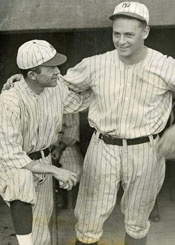  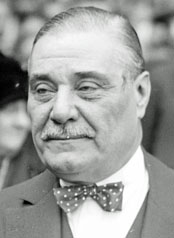 L-R: Miller Huggins, Waite Hoyt, T. L. Huston, Jacob Ruppert If someone was making book on who would hit the first World Series home run at Yankee Stadium, the overwhelming favorite would have been Babe Ruth, who had clouted 41 four-baggers in the new stadium that season. Instead, it was a visiting Giant who would one day manage the Yankees to ten American League pennants.
McGraw Starts Watson
McGraw was coy about his Game One starter. The Giants had five starters with double-figure victory totals: Hugh McQuillan (15-14), Rosy Ryan (16-5), Jack Scott (16-7), Art Nehf (13-10), and Jack Bentley (13-8). "I cannot really say. It all depends on how the pitchers warm up before the game. I'll look them over and the man I figure the best will get the job."
McGraw's choice was "None of the above." Righthander John "Mule" Watson had been plagued by a sore arm most of the season. He pitched in only 17 games, starting 15, after being traded by the Boston Braves to the Giants June 7. He compiled an ERA of 3.41 in 108 1/3 innings.
Watson's claim to fame is that he is the last major league pitcher to start both games of a doubleheader twice in one season.
   L-R: John Watson, Joe Dugan, Bob Meusel, Aaron Ward Huggins went with righthander Waite Hoyt (17-9, 3.02), a veteran of four World Series starts the previous two years.
The Yankees made quick work of Watson. They scored a run in the first on a walk to SS Joe Dugan and a double by LF Bob Meusel. Then they added two in the second on singles by 2B Aaron Ward and C Wally Schang, a sacrifice, and a two-out single by CF Whitey Witt. McGraw had seen enough and pinch-hit for Watson in the top of the third.
Giants Explode in Third
Down 3-0, the Giants took the lead and sent Hoyt to the showers in the top of the third. They loaded the bases with none out on singles by 1B George Kelly and PH Jack Bentley with a walk to C Hank Gowdy in between. SS Dave Bancroft grounded into a forceout to score one run, then stole second. When 3B Heinie Groh smacked a triple to score two more runs, Huggins signaled for Bullet Joe Bush to relieve Hoyt. 2B Frankie Frisch greeted him with a single to right field to knock in Groh and give the Giants a 4-3 lead.
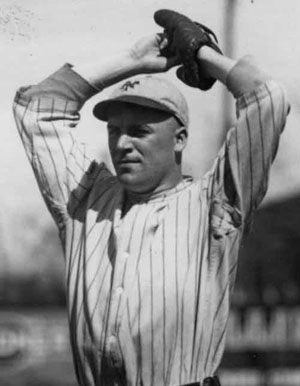   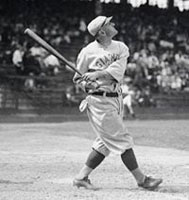 L-R: Rosy Ryan, George Kelly, Irish Meusel, Casey Stengel Ruth Triples; Frisch's Brilliant Play Prevents Run
After flying out to deep left field in the third, Ruth came to bat in the fifth with one out and nobody on base. He again hit the ball to the opposite field, this time "a wicked liner." Irish Meusel handled the hit slowly, believing Ruth would pull up at second. Instead, displaying his underrated speed, Babe flew around the bases for a triple.
The next batter, Bob Meusel, lifted a looping fly over second base. Running at top speed, Frisch grabbed the ball over his shoulder. Ruth set sail for home, but the Giant second sacker turned quickly and threw the ball on a line to C Frank Snyder, who tagged Babe several feet from the plate to complete the double play as the 6'2" base runner and 6'2" catcher both rolled to the ground.
Yankees Tie the Score
Neither team scored again until the bottom of the seventh when the Yanks tied the score on Bush's single and 3B Joe Dugan's line drive triple to left-centerfield. It was the first run off Rosy Ryan who replaced Watson in the third. With a chance to put the Yankees ahead, RF Babe Ruth grounded to 1B George Kelly, who threw out Dugan at home. Meusel then flied out to end the uprising.
A scoreless eighth set the stage for an exciting finish.
Bush had set down the Giants without a run for 5 2/3 innings after replacing Hoyt on the mound. He seemed on his way to extending his scoreless ledger when he retired Youngs and Irish Meusel to start the top of the ninth.
Up came "bandy-legged" CF Casey Stengel. He had played in 75 games for the Giants, batting .339 but without much power - just 21 extra-base hits, only five of which were homers despite playing in the Polo Grounds with its cozy 258' distance down the right field line. But there's another way to hit a home run other than knocking the ball over the fence.
As the New York Times reporter wrote the next day, "It was 'Casey at the Bat' all over again, but this time the great Casey did not strike out."
Stengel worked the count full, then hit the next pitch on a sharp line to left-centerfield. The ball landed between LF Meusel and CF Witt and rolled to the fence in the deepest part of the outfield. "With one leg injured and the other not as young and spry as it used to be, Casey ran the race of his life." Witt retrieved the ball and flung it to Meusel, who in turn threw it toward the plate as Stengel, running with all his 33-year-old might, rounded third "badly winded but still going strong. Casey slid into the plate and up onto one knee in a single motion" just before the ball reached C Schang. On his journey, Stengel merrily thumbed his nose at the Yankee bench.
Watch Stengel's race around the bases ... Casey retired to the clubhouse and was replaced in center field by Bill Cunningham.
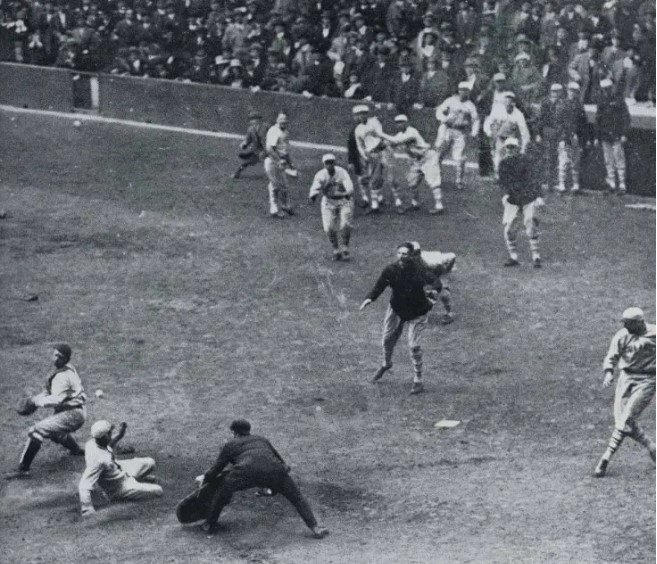 Stengel slides into home as the ball bounces past C Wally Schang. Many years later, Stengel recalled the play. "I was coming to third base and then I had this cushion in my shoe here [pointing to his heel]. Half the foot was hurting me, and I had this cushion to protect it, and when I'm running the cushion comes out of the shoe, and now the foot hurts when I'm running, and I am running against the best arm in baseball [Bob Meusel], so it showed you how speedy I was."
One of the Yankee owners, Jacob Ruppert, complained to Commissioner Landis about Stengel's thumbing his nose at the Yankee bench and demanded that the brash Giant be punished. But Landis shrugged it off. When someone asked Ruth his opinion about Stengel's action, Babe replied "I don't mind. Casey's a lot of fun." Ryan retired the Yankees in order in the bottom of the ninth to preserve the victory, the eighth in a row by the Giants over their Bronx rivals in World Series play.
References
The World Series: A Complete Pictorial History, John Devaney and Burt Goldblatt (1972) Babe: The Legend Comes to Life, Robert W. Creamer (1974) John McGraw, Charles Alexander (1988) The Man in the Dugout, Leonard Koppett (1993) |